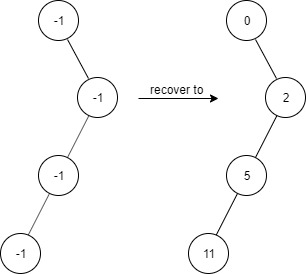Algorithm
Problem Name: 1261. Find Elements in a Contaminated Binary Tree
Given a binary tree with the following rules:
root.val == 0- If
treeNode.val == xandtreeNode.left != null, thentreeNode.left.val == 2 * x + 1 - If
treeNode.val == xandtreeNode.right != null, thentreeNode.right.val == 2 * x + 2
Now the binary tree is contaminated, which means all treeNode.val have been changed to -1.
Implement the FindElements class:
FindElements(TreeNode* root)Initializes the object with a contaminated binary tree and recovers it.bool find(int target)Returnstrueif thetargetvalue exists in the recovered binary tree.
Example 1:

Input ["FindElements","find","find"] [[[-1,null,-1]],[1],[2]] Output [null,false,true] Explanation FindElements findElements = new FindElements([-1,null,-1]); findElements.find(1); // return False findElements.find(2); // return True
Example 2:

Input ["FindElements","find","find","find"] [[[-1,-1,-1,-1,-1]],[1],[3],[5]] Output [null,true,true,false] Explanation FindElements findElements = new FindElements([-1,-1,-1,-1,-1]); findElements.find(1); // return True findElements.find(3); // return True findElements.find(5); // return False
Example 3:

Input ["FindElements","find","find","find","find"] [[[-1,null,-1,-1,null,-1]],[2],[3],[4],[5]] Output [null,true,false,false,true] Explanation FindElements findElements = new FindElements([-1,null,-1,-1,null,-1]); findElements.find(2); // return True findElements.find(3); // return False findElements.find(4); // return False findElements.find(5); // return True
Constraints:
TreeNode.val == -1- The height of the binary tree is less than or equal to
20 - The total number of nodes is between
[1, 104] - Total calls of
find()is between[1, 104] 0 <= target <= 106
Code Examples
#1 Code Example with Java Programming
Code -
Java Programming
class FindElements {
private Set set;
public FindElements(TreeNode root) {
set = new HashSet < >();
recover(root, 0);
}
private void recover(TreeNode root, int value) {
if (root == null) {
return;
}
set.add(value);
recover(root.left, 2 * value + 1);
recover(root.right, 2 * value + 2);
}
public boolean find(int target) {
return set.contains(target);
}
}
Input
Output
#2 Code Example with Javascript Programming
Code -
Javascript Programming
const FindElements = function(root) {
this.root = root
this.set = new Set()
if(root) this.set.add(0)
dfs(root, 0, this.set)
// console.log(this.set)
function dfs(node, cur, set) {
if(node == null) return
if(node.left) {
const child = cur * 2 + 1
set.add(child)
dfs(node.left, child, set)
}
if(node.right) {
const child = cur * 2 + 2
set.add(child)
dfs(node.right, child, set)
}
}
};
FindElements.prototype.find = function(target) {
return this.set.has(target)
};
Input
Output
#3 Code Example with Python Programming
Code -
Python Programming
class FindElements:
def dfs(self, node: TreeNode, real: int = 0):
if node:
node.val = real
self.nums.add(node.val)
self.dfs(node.left, real * 2 + 1)
self.dfs(node.right, real * 2 + 2)
def __init__(self, root: TreeNode):
self.root = root
self.nums = set()
self.dfs(root)
def find(self, target: int) -> bool:
return target in self.nums
Input
Output
#4 Code Example with C# Programming
Code -
C# Programming
using System.Collections.Generic;
namespace LeetCode
{
public class _1261_FindElementsInAContaminatedBinaryTree
{
private readonly HashSet < int> values;
public _1261_FindElementsInAContaminatedBinaryTree(TreeNode root)
{
values = new HashSet<int>();
Recover(root, 0);
}
public bool Find(int target)
{
return values.Contains(target);
}
private void Recover(TreeNode node, int value)
{
if (node == null) return;
node.val = value;
values.Add(value);
Recover(node.left, 2 * value + 1);
Recover(node.right, 2 * value + 2);
}
}
}
Input
Output
